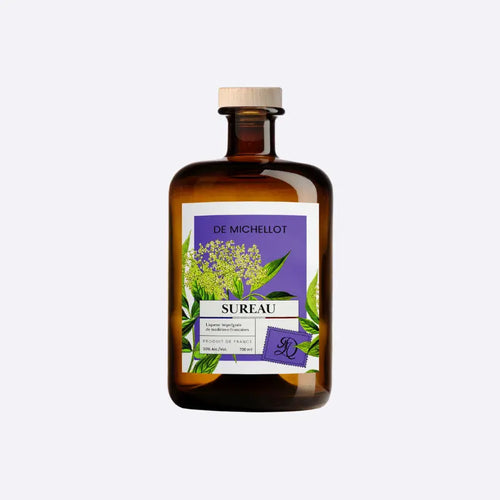Introduction
An icon of bars around the world, Jägermeister is a German herbal liqueur that is instantly recognizable thanks to its green bottle and iconic stag.
But behind this popular symbol hides a real botanical liqueur , rich in more than 56 plants, roots and spices .
Let's discover its history, its unique taste, its composition and its uses, as well as a French artisanal alternative by De Michellot .
The History of Jägermeister: From the Forests of Germany to the Bars of the World
Created in 1934 in Wolfenbüttel (Lower Saxony) by Curt Mast , the Jägermeister (literally “master hunter”) takes its name from a German honorary title awarded to forest rangers.
The logo of the deer with the luminous cross pays homage to Saint Hubert , patron saint of hunters.
This liqueur quickly established itself as a drink of conviviality and tradition , before becoming an international brand in the 1970s.
🌿 Today, more than 100 million bottles are sold each year in more than 150 countries.
The composition of Jägermeister
Jägermeister is an herbal liqueur made from 56 carefully selected botanical ingredients .
The exact recipe remains secret, but we know some of its components:
Plants and spices used
-
🌿 Gentian root
-
🌼 Chamomile flower
-
🍊 Bitter orange peel
-
🌰 Licorice
-
🍃 Mint, anise, ginger, clove
These ingredients are macerated for several weeks in neutral alcohol, then aged for a year in oak barrels , before being sweetened and filtered.
The result: a bitter, sweet and spicy liqueur with a complex aromatic profile.
The taste of Jägermeister
Jägermeister seduces with its balance between bitterness and sweetness , typical of herbal liqueurs.
Taste profile
-
🌿 Light bitterness provided by gentian and licorice root.
-
🍯 Sweet softness that softens the vegetal notes.
-
🍊 Hints of citrus and spices (ginger, clove, anise).
Its syrupy texture and herbaceous taste make it a unique spirit, at the crossroads of monastic and modern traditions.
How to drink Jägermeister?
In an iced shot
This is the most popular way to consume it.
Served very cold (-18°C) , it reveals its aromas without excess sugar.
In a cocktail
The Jägermeister is very versatile in mixology:
-
Jäger Tonic : 4 cl of Jägermeister + 10 cl of tonic + ice cubes.
-
Jäger Mule : Jägermeister + ginger beer + lime.
-
Black Negroni : gin + vermouth + Jägermeister, for a German version of the Negroni.
🍸 Its spicy notes pair perfectly with bitter or lemony flavors.
As a digestive
Like any herbal liqueur, it is ideal after a heavy meal , to aid digestion.
Jägermeister vs. French artisanal liqueurs
If Jägermeister embodies German tradition , France also has a long history of artisanal herbal liqueurs , more natural and floral.
Michellot's French alternatives
Michellot Plant Liqueurs perpetuate this botanical tradition, with 100% French recipes:
-
Gentiane De Michellot → floral and elegant bitterness.
-
Génépi De Michellot → alpine, floral and vegetal sweetness.
-
Verbena De Michellot → lemony and digestive freshness.
-
Michellot Mint → distilled, pure and refreshing.
🌿 Natural liqueurs, without artificial colors or flavors, perfect for lovers of authentic taste.
Jägermeister and herbal liqueurs around the world
Jägermeister belongs to the large family of European herbal liqueurs , alongside Chartreuse , Génépi and Bénédictine .
They all share a common philosophy: extracting the best from plants to create a balance between health and pleasure .
The difference?
French artisanal liqueurs , such as those from De Michellot , are distinguished by their aromatic purity and finesse , whereas Jägermeister takes on a sweeter and spicier profile.
French cocktails inspired by Jägermeister
The French Herbal Mule
-
4 cl of Gentiane De Michellot
-
10 cl of ginger beer
-
1 cl of lime juice
-
Mint leaves
A floral and elegant version of the famous Jäger Mule.
The Negroni of the Alps
-
3 cl of Génépi De Michellot
-
3 cl of French gin
-
3 cl of red vermouth
A natural alternative to the Black Negroni.
Jägermeister: a global success, a French inspiration
Having become a cultural symbol, Jägermeister continues to inspire the new generation of artisanal liqueur producers .
French houses like De Michellot are taking up this heritage and adding their own touch:
the refinement of the terroir , respect for the plant and a rediscovered taste authenticity .
🍃 From Michellot: the renaissance of French herbal liqueurs, between tradition and modernity.
Conclusion
Jägermeister is much more than just a liqueur: it is an icon of European spirits heritage .
But beyond the German legend, France also has its own art of natural herbal liqueurs .
🌿 Discover Michellot's Plant Liqueurs — an elegant and authentic French artisanal alternative to the famous Jägermeister.
Jägermeister, Jägermeister alcohol, herbal liqueur, German liqueur, herbal liqueur, Jagermeister composition, Jagermeister cocktail, Jagermeister digestif, Jagermeister alternative, French artisanal liqueur
